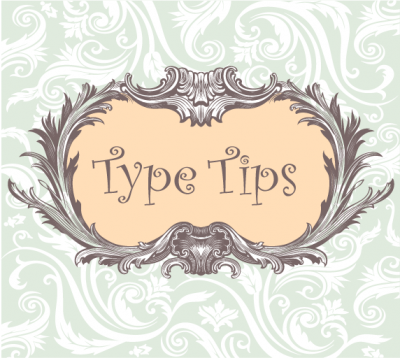
The choice of type is an important decision. Type conveys the flavor of your message when you are sharing your words in print, on a computer or smart device screen.
I am especially sensitive to the look and feel of type. I own more than 1000 fonts, so many that I recently had to disable many of them to avoid slowing down my computer.
My fascination with the structure and beauty of typography began over 30 years ago. You can see examples of type as a branding element when you go to the grocery store. Some of the most famous examples of typographical branding include Coca-Cola, Pepsi, CBS, Jack in the Box, Costco, Macy’s and Target. They may also use other graphic elements, yet you easily recognize their names when you see them.
Typography can be used to make your point, evoke strong feelings, act as a focal point to draw your attention to what is important. When used improperly, the choice of type cause confusion, be hard to read, or convey the opposite meaning from what is intended.
In my opinion, and one that is shared by most designers I know, one of the best books ever written about typography is a very small volume written and originally published as a handout for the graphic design special interest group of the North Coast Mac user group. I’m talking about “the non-designers design book” by Robin Williams. The companion book, “ your Mac is not a typewriter” is equally valuable and well known. They were written at the start of the desktop publishing revolution and the wisdom is just as valuable today. The principles of good design haven’t changed. They methods we use to deliver our message have changed. The principles of good design still apply.
I consider these two tiny books to be a “must read” for anyone who intends to use words in a visual format to communicate with others. You can find books through Peachpit Press (members of the North Coast Mac Users get a significant discount and can order then at a meeting — go to www.ncmug.org for details.) I first started using these books when I was a student in the graphic arts program at Santa Rosa Junior College, and again when I began teaching graphic design and communication.
I was extremely fortunate to meet and learn from Robin. We met when she was a part-time instructor at SRJC and as a frequent presenter at the NCMUG graphic arts group. Robin is a very witty and dedicated lover of typography. She went on to take her workshop handouts and transform them into these books. Since that time, she has written many more excellent books on design, also available through Peachpit. Generations of graphic artists everywhere are indebted to her for these clear, visually powerful and fun books that are good foundation for professional, digital, typesetting.
There is no excuse for poorly executed typography when we have so many powerful tools and an endless inventory of type available to us. Back in the days when type was set by hand withi lead type, writers never thought about laying out their words for print themselves. They concentrated on their stories and left the typesetting to the experts. Today most of us use a computer to compose and to prepare our written words for publication. Owning a computer does not a typographer or graphic designer make. If you intend to enhance your message and share it, educate yourself about type or collaborate with a trained, professional book designer to transform your words into beautifully set type.
Spend an afternoon becoming familiar with the content of these two books. I guarantee your investment will be rewarded. Even if you have no interest in doing it yourself, becoming an informed consumer will help you direct your book cover designer, your book interior designer and your e-book designer with the information you need to make your writing as beautiful and as memorable as your writing.
Judy Baker is Completely Creative. Trained and certified by Robert Middleton as an Action Plan Marketing Coach. She is a branding expert who helps authors, speakers and entrepreneurs and create visual and verbal brands that attract customers.
She specializes in developing brands that connect emotionally and move people to take action. An alumnus of Robert Mondavi Winery, Judy is an engaging speaker and workshop leader. A graduate of San Diego State with a B.A. in Drama and a Master in Human Resources and Organization Behavior from the University of San Francisco, she has been a student and instructor in graphic design at Santa Rosa Junior College.
Judy is the President of the Board of the Bay Area Independent Publishers Association, an organizer the Wine Country WordPress Meetup, Program Chair for f the Bay Area Consultant’s Network and a tenor with Vox Populi Sonoma, a rock choir. Her business expertise includes strategies for turning expertise into information products. She lives in Sonoma with her husband and cork-fetching cat, Simba, her spouse, Garry, and a house and office full of books. Visit her online at http://www.creative1.com









You must log in to post a comment.